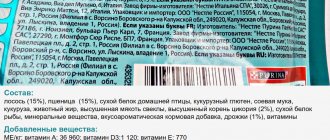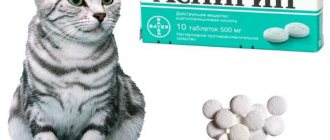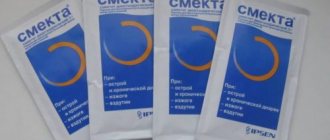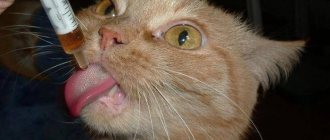The benefits and harms of activated carbon for cats
Activated carbon has many positive characteristics, but, depending on the method of application, it can have a negative effect on the body.
Activated carbon
Advantages:
- In emergency situations, it will serve as a quick help to improve the animal’s condition.
- Absorbs toxins from the cat's body, which are then excreted through feces.
- Helps reduce flatulence after eating.
- Reduces side effects after the use of anthelmintics.
Flaws:
- With prolonged use, it causes addiction and the body’s inability to cope with diarrhea on its own.
- When consumed regularly, it removes beneficial substances from the animal’s body.
- Can negatively affect the liver.
Overdose
Side effects from activated carbon are rare; symptoms of overdose correspond to severe constipation. Since the drug, as mentioned above, absorbs a large amount of liquid and mucus.
Symptoms:
- the animal tries to go to the toilet, strains, but feces do not come out;
- severe dehydration; if you lift a cat by the withers, it then does not straighten out for some time;
- dry, cracked stool;
- stomach ache;
- a lump is felt in the abdomen.
a large amount of water along with the charcoal . Enveloping drugs and agents that enhance intestinal motility will help the dense lump come out (the latter may not be given in case of diarrhea).
Purpose and effect of the drug
Often more properties are attributed to this medicine than it actually is. To determine what is a myth and what is true, situations in which activated carbon has different effects are discussed below.
In case of poisoning
What to give your cat for diarrhea at home
Activated carbon provides emergency treatment for acute poisoning after taking a large amount of a toxin or drug. Effectiveness depends on the time elapsed since ingestion, the type of toxin, and its ability to bind to activated charcoal.
Important! Activated charcoal should be given as soon as possible after ingesting the poison. Used within 1 hour of poisoning, it can reduce the absorption of toxins by up to 75%.
Can diarrhea be treated with charcoal?
Charcoal is more effective in preventing toxicity in the body, but it is considered useless against diarrhea. For diarrhea in animals, it is necessary to use other medications.
It is necessary to give the cat the opportunity to get acquainted with the medicine
Prevention remedy
Activated charcoal is rarely used for preventive purposes, as most owners monitor their pets and what they eat. But if the animal finds itself in a new place without constant control by the owner, then this adsorbent is perfect as a preventative against poisoning or if it is predisposed to allergies.
How to give the drug to animals?
Almost all cats resist when the owner tries to give him a pill. Of course, because their unusual taste is far from their favorite food. This will require some skill. Here are the step by step steps.
- Place the pet on your lap so that its hind legs rest on the owner's stomach.
- Use your left hand to lift the animal's head. Pull your lower lip towards the back of your head. In cats, after 4 lower and 6 upper premolars, there are no further teeth. This makes it easier to administer the medication into the mouth. By pulling the lower lip back, at the root of the cat's tongue you can see a hollow hole into which a syringe fits perfectly.
- You cannot lower the animal’s head down or remove your hand until he swallows. To stimulate the swallowing movement, you need to stroke it along the neck.
It is important to properly restrain the cat before giving the drug.
If the owner is afraid of being scratched, then you can ask other family members for help or simply wrap the animal in a blanket or towel so that if the opportunity arises, he will not let go of his claws.
The whole tablet can be given to the cat. You need to press your fingers on the area between the upper and lower lips. In this case, the animal’s head should be raised. When the pet's mouth opens, a tablet is placed on the root of the tongue. Then the jaws close. You cannot remove your hands until the animal makes a swallowing movement.
Video - How to give pills to cats?
After swallowing the tablet, the cat must be given water. He must drink at least 1 glass per day. In order for the drug to help your pet, you should know what dosage is acceptable for it.
When coal won't help
Painkillers for cats: which ones can you give?
Activated carbon is ineffective in treating poisoning by the following substances:
- inorganic toxins: ammonia, borates and borax, bromide, fluoride, chlorates, cyanide, iodide, nitrates and nitrites, phosphorus, sodium chloride;
- heavy metals: arsenic, copper, iron, lead, lithium;
- caustic acids and alkalis, cationic detergents, paraquat and diquat;
- petroleum products: kerosene, xylene;
- substances with small polar molecules: alcohols, ethylene glycol, urea.
When should you give the medicine?
In what cases is it permissible to use this drug? There are several indications when a substance will be useful for an animal.
Indications:
- Disruption of the digestive system;
- Allergic reactions to food;
- Liver diseases;
- Poisoning with various substances;
- Intestinal upset, diarrhea;
- Infectious diseases;
The drug does not harm the animal, but it is not recommended to abuse it.
It is allowed to replace the drug with its analogue - white coal. This product contains silicon dioxide, which binds and removes toxic compounds from the dog’s stomach and intestines.
Dosage of activated carbon per cat head
Recommended doses range from 1 to 5 g per kilogram of body weight. In some cases, repeat doses may need to be considered. This is necessary for toxins that recirculate, when taking slow-release medications, or for toxins with a long half-life. Half of the first dose is given again at intervals of 4-8 hours 3-4 times.
There are several ways to give activated charcoal to your cat. The dry drug is mixed with water to prepare a suspension and administered orally using a large syringe or a special probe. If a syringe is used, care should be taken to avoid inhalation of air by the animal. The product can also be added to food so that the animal eats it voluntarily.
Charcoal solution for cats in a syringe
Important! The powder should not be mixed with ice cream, sherbet, milk or sugar syrup.
Prevention of poisoning in cats
For preventive purposes, the medicine is prescribed 1 tablet per day, by mixing it with food. Before adding it, it must be crushed into powder and mixed into food in small portions throughout the day, so that the pet does not sense the presence of the medicine.
Also, for the purpose of prevention, certain points that can provoke poisoning should be observed:
- It is not recommended to grow poisonous plants at home;
- medicines and household chemicals should be kept out of the reach of your pet;
- do not leave food that is not intended for animal consumption unattended;
- close the trash can tightly;
- carry out preventive measures against fleas and ticks in a timely manner, but only with products for cats and taking into account weight (replacing the medicine with an analogue for dogs can provoke poisoning).
To summarize, we can say that activated charcoal can be given to a cat at the first symptoms of poisoning. However, if there is no improvement within 24 hours or if the pet becomes worse after taking it, then you should contact a veterinary clinic to prescribe effective treatment.
Contraindications and side effects
Contraindications to the use of activated carbon are:
- unprotected airways;
- gastrointestinal perforation and animals at risk of gastrointestinal perforation or hemorrhage;
- aspiration risk;
- obstruction of the gastrointestinal tract;
- Use with caution in case of hyperosmolar disease.
In general, complications with drug administration are relatively rare. Exceeding the dose to 15 grams/kg is not fatal. Some animals may vomit. Repeated dosage may cause constipation.
A potential complication is hypernatremia. This is seen in young animals or in cats receiving multiple doses.
It is recommended to monitor sodium levels 2-4 hours after taking the drug.
Important! To prevent the development of hypernatremia, pets may be placed on intravenous fluids, especially if they are dehydrated.
Indications for use
According to the instructions, the drug is used for the following diseases:
- poisoning with poisons and drugs;
- diarrhea;
- allergic dermatitis;
- increased gas formation in the intestines;
- liver pathologies;
- acute infectious diseases that disrupt digestive processes.
Before giving your kitten charcoal, you should contact your veterinarian for diagnosis and treatment aimed directly at the cause of the disease.
After the examination, the doctor will give recommendations on taking the sorbent.
Pharmaceutical analogues
Activated carbon has effective analogues:
- "Smecta". A harmless drug with zero risk of complications. Quickly relieves irritable bowel symptoms. Diluted in water in a ratio of 1:2 tsp. and is consumed 2 times a day.
- "Polysorb". The main substance is silicon dioxide, which is much more effective than activated carbon. Reduces symptoms of poisoning within 10 minutes. The suspension should be dissolved in 30 ml of water at a rate of 1 mg/1 kg of body weight and consumed 5 times a day.
- "Enterosgel". Has contraindications. To alleviate the condition, one application is enough: 1 tsp. 2 times a day 3 hours before meals.
- "Polyphepan". Consists of hydrolytic lingin, activated carbon. Take 1 tsp three times a day. 30 minutes before meals.
Important! Before using these products, read the instructions and possible contraindications.
The use of activated carbon plays an important role in rescuing a poisoned animal. Animal owners should be aware of the indications, method of use and possible consequences observed when taking the drug. Before using a medicine, it is important to evaluate the benefits and risks.
Is it possible to give coal to a dog?
Can I give this drug to a dog? This sorbent is used for animals. Charcoal helps remove toxic substances from the body and prevents toxic compounds from being absorbed into the intestines.
You will like the article: “ How salmonellosis manifests itself in dogs - the first symptoms and methods of treatment .”
The product is tasteless and odorless, so you can simply give it to your dog. When using, you must follow the instructions and accurately calculate how much activated carbon you are allowed to give to your pet.
Additional actions in case of poisoning
IMPORTANT . A dog that has consumed unsuitable food or a toxic substance must be rescued as quickly as possible.
At the first signs of poisoning in your pet, you should:
- try to provoke vomiting in the dog or give him a large amount of water to drink if more than 2 hours have passed since intoxication;
- use an enema for cleansing;
- activated carbon inside with Vaseline oil.
The owner’s task is first of all to remove the remnants of unabsorbed toxic elements from the pet’s body. Everything needs to be done as quickly as possible. If toxins are fully absorbed into the blood, the treatment will be more difficult and longer. Carry out all subsequent actions in the clinic under the close supervision of specialists. This is especially true for severe poisoning.
Consultation with a doctor is required, even if you observe minor ailments in the animal. It is necessary to exclude possible serious diseases hidden behind signs of poisoning. It is impossible to do this on your own.
Dogs are curious creatures. Pets require special care and attention. And although activated carbon is harmless and even useful, any disease must be foreseen before being treated.
What is Activated Carbon?
To understand exactly how “Activated Carbon” helps get rid of intoxication in the body, you need to find out what it is.
So, this tool is absolutely familiar to us, because:
- it is effective;
- sold in any human pharmacy;
- costs mere pennies.
“Activated carbon” is absolutely non-toxic and is highly effective in absorbing and removing toxic substances
This drug is a sorbent. Its color is standard for coal – black. Upon contact with liquid, it begins to hiss. Its taste is neutral, unsaturated.
The drug acts as follows: when swallowed, it enters the intestines through the gastrointestinal tract, where it adsorbs toxic substances. The purpose of this remedy is to prevent harmful substances from being absorbed into the blood through the intestinal walls. That is why you need to use it as quickly as possible.
“Activated carbon” helps dogs and humans with almost any poisoning. So, for example, it makes it easier:
- alcohol poisoning;
- consequences of eating spoiled food;
- poisoning with salts of heavy metals;
- intoxication from industrial emissions, etc.
A dog, like a person, can be poisoned by spoiled food or any toxic substances
The effect of the drug can be divided into two main stages. Let's see which ones in the table below.
Table. Stages of operation of "Activated carbon"
| Adsorption | Removal |
| Adsorption is the process of absorption of toxic substances by an Activated Carbon tablet. Unfortunately, this drug cannot have a targeted effect, so along with harmful substances it also contains useful ones. However, such a one-time loss of positive substances is nothing compared to the amount of toxin that can be removed from the body of a living being in one dose | Removal of the product, as well as the toxin contained within it, after absorption, is carried out absolutely naturally - through defecation. It is very important to drink a lot of water when using Activated Charcoal, as it:
|
It is not possible to get an overdose from taking the drug too actively.
Activated carbon itself does not pose any danger
This medication is eliminated from the body of dogs in approximately 10 hours, and the pet’s stool may turn black. This should not scare you, because feces darken precisely from mixing with them a coloring substance - coal.
Content
1. General description 2. Composition and action 3. Purpose 4. Dosage and application features 5. Limitations 6. Price and analogues 7. Reviews
Perhaps anyone knows that the first remedy for poisoning and diarrhea can be activated carbon. What if your pet is poisoned? Can activated charcoal be useful and, most importantly, safe for dogs? Experts say that this effective and inexpensive drug will help with diarrhea and vomiting caused by poisoning in animals.
Restrictions
Activated carbon should not be given to animals with gastric bleeding, peptic ulcers, or individual intolerance to the drug. Coal turns feces black - this is a natural condition that should not be alarmed.
Important!
When using activated carbon, it is necessary for the dog to drink as much clean water as possible: it enhances the effectiveness of the drug, helps reduce intoxication in the body, and softens the feces so that it moves more freely through the intestines.
Video: how to give a dog a pill
Read more:
What to do if your dog is poisoned by rat poison?
Tubazide poisoning of dogs and people - symptoms and consequences
What powder to take in case of poisoning for children and adults ▶
Regidron for a hangover: how to take it correctly, instructions
Saline solution for poisoning, diarrhea or vomiting
Article rating:
( 1 ratings, average: 5.00 out of 5)
Share with friends:
You may also be interested in:
What to do if a kitten is poisoned?
Treatment methods for gastroenteritis and coronavirus infection in cats
How to use rehydron for dogs for vomiting and diarrhea - dosage
What should you feed your dog in case of poisoning?
Treatment of poisoning
Positive treatment largely depends on how quickly first aid was provided.
Treatment for poisoning includes:
- Stopping the effect of poison on the body.
- Removing a toxic substance from the body: washing the stomach and intestines by prescribing emetics, laxatives, adsorbents, and diuretics.
- Neutralization of poison (use of antidote, antidote).
- Symptomatic treatment depending on the symptoms accompanying poisoning.
It is not difficult to guess that the cat owner can independently do only two points out of the available four. Measures must be taken as soon as possible after the poison enters the body.
- Gastric lavage can be done with a large amount of water with the addition of table salt or baking soda.
- It would be a good idea to do an enema, in this case there is a chance to remove toxins from the body several times faster than with a simple gastric lavage.
- Apomorphine or potassium permanganate diluted in water is used as an emetic. It is advisable to always have these tools.
Activated carbon has always been the best adsorbent.
In case of poisoning, a good result is obtained by using mucous decoctions or coating substances (egg white, rice water, tannin solution, etc.). They cover the gastric mucosa and prevent poisons from being absorbed.
After all these measures, the cat must be taken to a veterinarian, where you can tell in detail about all the signs that have been observed over the past hours, and also suggest, and maybe say in the affirmative, what exactly the cat was poisoned with. It is important not to withhold information; the pet’s health will depend on its completeness. The doctor should also take samples of vomit and feces, if any.
KotoDigest
Thank you for subscribing, check your inbox: you should receive an email asking you to confirm your subscription
“Activated carbon” is a well-known sorbent that is used for various poisonings. Has a powerful adsorbing effect. The active component of the drug quickly envelops the gastric mucosa, which prevents harmful substances - heavy metal salts, narcotic components, poisons, chemicals, toxins - from entering the bloodstream.
"Activated carbon" for cats: application
Having decided to get a cat, the owner must understand that feeding, cleaning the animal’s litter box and combing it regularly is only half the battle. If you have a four-legged friend in the house, it is very important to ensure his complete safety. This is especially true for small kittens, who strive to taste something.
And this is not necessarily due to the fact that the owner does not feed his pet enough. Most likely, teething or a weakened sense of smell is to blame. Therefore, food that is not at all intended for a weak and fragile body often ends up in the stomach of little fidgets. Hence, gastric and intestinal disorders in the form of diarrhea, vomiting and other signs of intoxication.
How can you tell if an animal is poisoned? Here are the main symptoms:
- loose, watery stools, the frequency of which can be from 5 times per day;
- rapid breathing;
- refusal of food;
- dark urine, frequent urination;
- dry nose, dilated pupils;
- a radical change in behavior (an active cat becomes too calm, immobilized, sleeps all the time);
- putrid odor from the animal’s mouth, glow in the dark vomit (observed in case of phosphorus poisoning);
- heavy breathing, production of large amounts of saliva, swelling of the tongue and gums (acid poisoning);
- decreased temperature, ulcerations on the oral mucosa, paralysis, uremia (mercury poisoning);
- regurgitation, vomiting; in severe cases, convulsions, trembling, loss of consciousness, and paleness of the mucous membranes of the mouth are observed (this indicates the onset of dehydration).
If one of these signs is present, you need to sound the alarm. The best option is to contact a veterinarian. If this is not possible, then you urgently need to give your pet “Activated Carbon”. The drug is absolutely harmless to four-legged animals, so veterinarians recommend giving it in case of poisoning - and the sooner the better.
As mentioned earlier, activated carbon is the best remedy for treating poisoning. Unfortunately, cats get poisoned quite often, and this is due to two reasons. Firstly, these animals are very curious; they need to know what kind of powder is scattered on the floor and what is in the jug on the top shelf of your closet.
The main symptoms of poisoning are:
- vomiting and diarrhea;
- copious amounts of saliva;
- lethargy;
- disorientation in space;
- dilated pupils;
- hard breath.
If at least two symptoms are present, owners should already be wary of possible pet poisoning. In this case, you must contact your veterinarian and take your pet to him for examination. If this cannot be done, you can give activated charcoal to the cat; it will not be unnecessary, but will only be beneficial.











